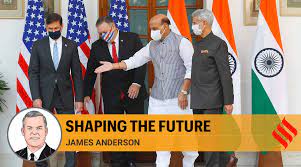
US-INDIA DEFENCE RELATIONS
US-INDIA DEFENCE RELATIONS , Daily Current Affairs , RACE IAS : Best IAS Coaching in Kanpur
Syllabus: GS 2 / International Relation
In News
- India and the US recently concluded an ambitious roadmap for defence industrial cooperation to fast-track technology tie-ups and co-production of military platforms such as air combat and land systems.
About
- The new framework for cooperation was finalised during talks between Defence Minister Rajnath Singh and his visiting American counterpart Lloyd Austin.
- Both agreed to initiate negotiations on a framework for the security of supply arrangement and a reciprocal defence procurement agreement, which will promote long-term supply chain stability.
- Both sides also touched upon General Electric's proposal to share technology with India for fighter jet engines and New Delhi's plan to procure 30 MQ-9B armed drones for over USD 3 billion from US defence major General Atomics Aeronautical Systems Inc.
- India-US partnership is critical for ensuring a free, open and rules-bound Indo-Pacific region.
- They also welcomed the establishment of the India-US Defence Acceleration Ecosystem (INDUS-X), a new initiative to advance cutting-edge technology cooperation.
Overview of India-US defence relations
- New Framework for India-U.S. Defence Relationship(2005):
o The agreement has emerged as a major pillar of India-U.S. strategic partnership and resulting intensification in defence trade, joint exercises, personnel exchanges, collaboration and cooperation in maritime security.
o The Defence Framework Agreement was updated and renewed for another 10 years in June 2015.
- Defense Technology and Trade Initiative (DTTI):
o DTTI, launched in 2012 to bring focus on the bilateral defence trade relationship, creates opportunities for the U.S.-India co-production and codevelopment, and fostering more sophisticated science and technology cooperation.
- Bilateral Exercises:
o MALABAR exercise:It began as an annual bilateral naval exercise between India and the US in 1992.Later Japan and Australia joined it in 2015 and 2020 respectively.
o Yudh Abhyas:India-U.S. Army exercise began in 2002.
o Cope India: Air Exercise between the Indian Air Force and United States Air Force began in 2004.
- Major Defence Partner: In June 2016, the U.S. recognised India as a "Major Defence Partner", which commits the U.S. to facilitate technology sharing with India to a level commensurate with that of its closest allies and partners, and industry collaboration for defence co-production and co-development.
Foundational defence agreement: India has signed all the four foundational defence agreements with the US.
1. General Security of Military Information Agreement (GSOMIA):
a. It was signed in 2002.
b. The agreement prescribed security standards and protocols for safeguarding information shared by the Pentagon with India’s defence ministry, as well as by US defence firms with Indian defence public sector undertakings (DPSUs).
2. Logistics Exchange Memorandum of Agreement (LEMOA):
a. It was signed in 2016.
b. LEMOA allows the militaries of the US and India to replenish from each other's bases, and access supplies, spare parts and services from each other’s land facilities, air bases, and ports, which can then be reimbursed.
3. Communications Compatibility and Security Agreement (COMCASA):
a. It was signed in 2018.
b. The signing of COMCASA paved the way for the transfer of communication security equipment from the US to India to facilitate “interoperability” between their forces — and potentially with other militaries that use US-origin systems for secure data links.
4. Basic Exchange and Cooperation Agreement (BECA):
a. It was Signed In 2020.
b. BECA will help India get real-time access to American geospatial intelligence that will enhance the accuracy of automated systems and weapons like missiles and armed drones.
c. Through the sharing of information on maps and satellite images, it will help India access topographical and aeronautical data, and advanced products that will aid in navigation and targeting.
Significance of India-US defence relations
- The defence cooperation between both the nations will help to counter China's aggressive measures in India's neighbourhood and also in the Indo-Pacific region.
- Co-development and co-production of existing and new technologies will strengthen the defence startup ecosystem of the two countries.
Challenges
- Russian apprehensions: India-US deepening ties is pushing Russia towards China, as the former consider the Indo-US relations a threat to its sovereignty.
- Critics argue that increasing defence ties with the US may portray India's image as a western ally.
Source: TH